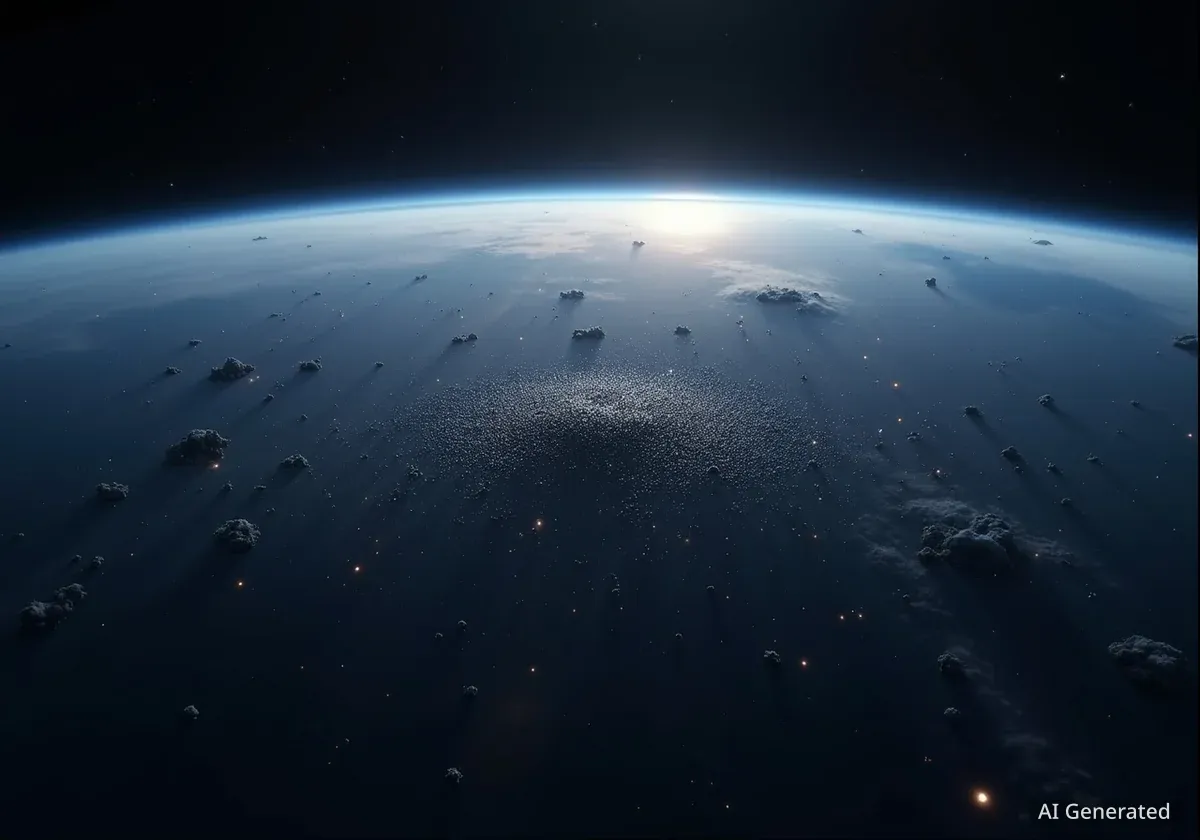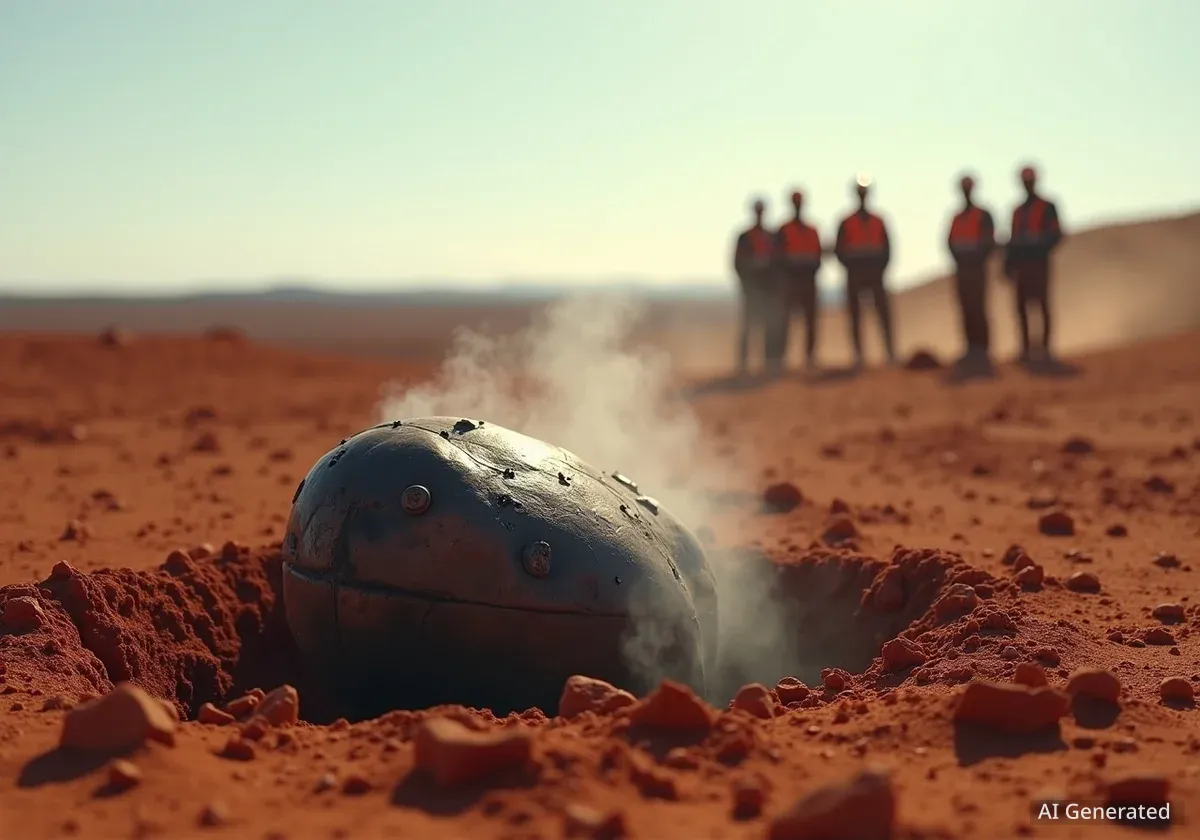An invisible field of high-velocity debris is encircling our planet, posing a significant and growing threat to the technology that underpins modern life. Traveling at speeds ten times faster than a bullet, millions of fragments from old satellites and rockets risk a chain reaction that could cripple global communication, navigation, and financial systems.
Key Takeaways
- Over 140 million pieces of human-made debris are estimated to be in Earth's orbit, ranging from tiny paint flecks to large rocket components.
- This debris travels at approximately 17,500 miles per hour, making even small fragments capable of destroying active satellites on impact.
- A major collision could trigger a cascading failure of satellite networks, disrupting essential services like GPS, internet, air traffic control, and banking.
- Debris is also beginning to affect Earth directly, with fragments surviving re-entry and impacting the ground, while burning metals in the atmosphere may pose a new climate risk.
An Orbital Minefield Above Our Heads
While pollution is often viewed as a terrestrial problem, the zone just beyond Earth's atmosphere has become a junkyard. Decades of space exploration have left a legacy of discarded rocket stages, defunct satellites, and countless smaller fragments from collisions and degradation.
According to estimates from the European Space Agency, the scale of the problem is immense. As of late 2023, there are thought to be around 54,000 objects larger than 10 cm in orbit. The number grows dramatically for smaller pieces, with an estimated 1.2 million objects between 1 cm and 10 cm, and a staggering 140 million fragments smaller than 1 cm.
Speed Kills
Orbital debris moves at an average speed of 17,500 mph. At this velocity, a collision with a piece of debris as small as a marble carries the kinetic energy of a bowling ball dropped from a skyscraper, easily disabling a multi-million dollar satellite.
This orbital minefield presents a direct physical threat to the operational satellites we depend on, as well as to crewed missions and the International Space Station. Astronaut safety is a primary concern, requiring heavily shielded spacecraft and constant tracking of larger debris to perform avoidance maneuvers.
The Domino Effect on Modern Society
The greatest danger posed by space debris is a theoretical scenario known as the Kessler Syndrome. This concept, proposed by NASA scientist Donald J. Kessler in 1978, describes a tipping point where the density of objects in low Earth orbit becomes so high that collisions create a cascade of new debris, leading to more collisions.
Such a chain reaction could render certain orbits unusable for generations, effectively trapping humanity on Earth and destroying the satellite infrastructure that forms the backbone of the global economy.
Our Reliance on Vulnerable Satellites
The consequences of a widespread satellite failure would be immediate and severe. Modern society is intricately woven with services provided from space:
- Global Positioning System (GPS): Essential for everything from personal navigation and ride-sharing apps to military operations, logistics, and precision agriculture.
- Communications: Satellites provide global internet access, television broadcasting, and vital communication links for remote areas and emergency services.
- Financial Transactions: Global financial markets rely on satellites for precise timing signals to synchronize transactions, including ATM withdrawals and stock market trades.
- Weather and Climate Monitoring: Satellites are our primary tool for forecasting weather, tracking storms, and collecting long-term data on climate change, such as melting ice caps and rising sea levels.
A sudden loss of these systems would not just be an inconvenience; it would trigger a global crisis, effectively resetting much of our technological progress to the mid-20th century overnight.
When Space Junk Comes Home
While most debris remains in orbit for years or even centuries, it does not all stay there forever. Earth's gravity gradually pulls objects down, and while most smaller pieces burn up harmlessly upon re-entry, larger components can and do survive to hit the ground.
Recent incidents have brought this issue from the theoretical to the real. In March 2024, a family in Florida experienced this firsthand when a piece of a cargo pallet jettisoned from the International Space Station tore through the roof of their home. The family has since filed an $80,000 claim against NASA for damages.
"For us down here on Earth, we are really not aware of this growing problem… and we are really not able to connect to it. Unless we make that human connection, it’s not something we would be able to address."
In another case, a large metal ring from a rocket, weighing nearly half a ton, landed in a village in Kenya. Fortunately, no one was injured in either incident, but they highlight the unpredictable nature of falling debris and raise complex legal questions about liability.
The Hidden Climate Threat
Beyond the physical impact of falling objects, scientists are now investigating the atmospheric effects of debris re-entry. As metal fragments burn up, they release tiny aerosol particles into the upper atmosphere. A recent study warned that these metallic particles could potentially warm the stratosphere by up to 1.5 degrees Celsius and contribute to the depletion of the protective ozone layer, adding a new, poorly understood dimension to climate change.
An Unregulated Frontier
Addressing the space debris problem is a challenge of international scope and immense technical difficulty. The foundational legal framework for space, the 1967 Outer Space Treaty, holds the launching state responsible for its space objects, but its application to fragmented debris is ambiguous.
A significant hurdle is the lack of any international mandate or incentive for cleanup. While some nations have guidelines for new satellites to be designed to de-orbit within 25 years of their mission's end, this is not a universal rule and does not address the millions of fragments already in orbit.
Currently, the most common disposal method is a controlled re-entry over a remote area of the South Pacific Ocean known as Point Nemo. However, this practice simply transfers the pollution from space to the ocean.
As commercial satellite constellations like Starlink and Amazon's Project Kuiper launch thousands of new satellites, the orbital environment is becoming more crowded than ever. Without a concerted global effort to track, manage, and begin removing the most dangerous debris, we risk closing off our access to space and damaging the technological systems that have come to define the 21st century.




